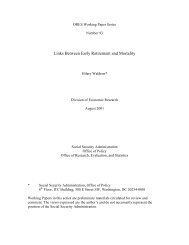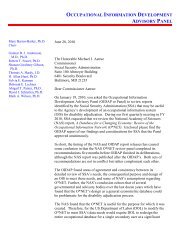Download entire publication - Social Security
Download entire publication - Social Security
Download entire publication - Social Security
Create successful ePaper yourself
Turn your PDF publications into a flip-book with our unique Google optimized e-Paper software.
Occupations of SSI Recipients Who Workby Jeffrey Hemmeter*This article uses the 2007 American Community Survey to estimate the occupational distribution of Supplemental<strong>Security</strong> Income (SSI) disability recipients aged 18–61 who work, and it compares their occupational distributionwith that of working nonrecipients with and without disabilities. Based on models of occupational choice forworking SSI recipients and nonrecipients, predicted occupational distributions are also estimated to understandwhat occupations are available to SSI recipients. Unlike the nonrecipient populations that are largely composedof sales- and office-based occupations (25 percent), the most common occupations of SSI recipients who work arein services (34 percent) and production, transportation, and material moving (30 percent), although sales- andoffice-based occupations are also common for SSI recipients (22 percent). The occupational distribution of workingSSI recipients is also more concentrated than that of nonrecipient populations.Dissimilarity indices are used to compare the predicted and actual occupational distributions of the SSIrecipient population and nonrecipient populations. More than one-half of the difference between the occupationsof working SSI recipients and nonrecipients can be explained by demographic characteristics, human capital,and disability type. Additionally, nonemployed SSI recipients have similar predicted occupational distributionsas currently employed SSI recipients. Given the estimated occupational distributions and the average earnings ofindividuals in the most common occupations of SSI recipients, the results suggest that more targeted vocationaltraining may provide expanded opportunities for employment.IntroductionThe <strong>Social</strong> <strong>Security</strong> Administration’s (SSA’s) involvementin back-to-work programs, vocational rehabilitationprograms, and programs generally designed tohelp recipients become economically self-sufficientwould benefit from an understanding of the types ofjobs available to Supplemental <strong>Security</strong> Income (SSI)recipients. With the exception of a few back-to-workstudies and work incentive demonstrations, relativelylittle is known about the occupations of SSI recipientsrelative to non-SSI recipients. This article fills a gap inknowledge about the types of jobs recipients have andhow this differs from the jobs of the nondisabled andnonrecipient populations.According to SSA (2008a), 5.7 percent (or 357,344)of the working-age (18–64) SSI population workedin December 2007. These individuals tend to havelow wages; average earnings from wages were $597in December. Knowledge of how the jobs theserecipients hold differ from those of nonrecipientscould help identify where vocational programs andplacement efforts should best be focused and whereoutreach may be necessary to ensure employmentopportunities for recipients. SSA is interested inassisting these individuals in becoming productivemembers of the economy and becoming self-sufficient.If individuals leave the SSI rolls but are trappedin marginal occupations (that is, occupations withlow pay and insufficient health insurance), they maynot only return to the program in the future, but maySelected AbbreviationsACSDIHHIIIANBSnon-LFPAmerican Community SurveyDisability InsuranceHerfindahl-Hirschman Indexindependence or irrelevant alternativesNational Beneficiary Surveynon–labor force participation* Jeffrey Hemmeter is an economist in the Office of Program Development and Research within the Office of Retirement and DisabilityPolicy, <strong>Social</strong> <strong>Security</strong> Administration.<strong>Social</strong> <strong>Security</strong> Bulletin • Vol. 69 • No. 3 • 2009 47








